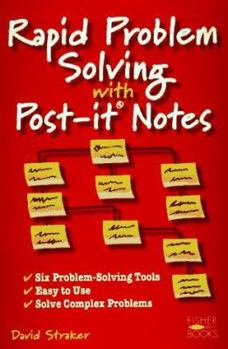Rapid Problem Solving with Post-It Notes
Select Format
Select Condition 
Book Overview
Problem Solved Uses your favorite top-drawer tool -- the Post-it Note. Great for individuals, great for groups -- large or small. Problems come in all shapes and sizes, yet most have common characteristics that can be addressed with the techniques found in this book. Rapid Problem-Solving with Post-it Notes shows you how to use six types of techniques: The Post-up-Provides methods for getting information into chunks The Swap Sort-Shows...
Format:Paperback
Language:English
ISBN:1555611427
ISBN13:9781555611422
Release Date:July 1997
Publisher:Da Capo Lifelong Books
Length:176 Pages
Weight:0.45 lbs.
Dimensions:0.4" x 6.1" x 8.0"
Customer Reviews
5 ratings
Constantly recommending this book to others
Published by Thriftbooks.com User , 17 years ago
I'm the author of "Thinkertoys: A Handbook of Creative Thinking Techniques," and other books on creative thinking. As such, I read pretty much everything that's published that can be useful in facilitating creative thinking workshops and seminars. I find the ideas in this book fun,useful and extremely effective. I'm constantly recomending it to people looking for ways to become more creative in their personal and business lives.
Simple, common powerful techniques... organized.
Published by Thriftbooks.com User , 17 years ago
Don't get fooled by the title, this is about using Post-It notes but the core of the book can be used easily without them. This book is about simple problem-solving tools that most people have already used, but presented in an organized way. These tools are not only for analysts or managers or X; they are for everyone who needs to solve problems like "what gift will I give to my friend?", "What are the core priorities of this project?", "How should I classify our product categories?", "what are the relationships among out departments?", etc. Please note that Post-It notes are used as enhancers of those simple problem-solving techniques, and they are used in very powerful ways. I didn't have ever considered the Post-It notes as serious material for my job; I thought they were only good for to-do listings. The book is very easy to read; also, it can be read as a reference book (to remind you how or when to use any of the techniques) or as a step-by-step tutorial. This is not a book with obscure quasi-magical problem-solving techniques only known by rocket science consultants... this is a book about very basic tools that will help you to solve most problems you will find everyday at work, at home, at wherever. Highly recommended for young people too.
A wonderful introduction to systems thinking
Published by Thriftbooks.com User , 22 years ago
This book is a real wonder. In a very friendly way, and without resorting to any technology beyond sticky notes, it introduces several concepts of computer science and systems engineering.It can be used as a brainstorming tool, but it can also be used by us programmers as a gift to the non-programmers in our lives. It can serve as an exposition of what it is we do all day when we aren't cursing irritating APIs and OS misfeatures. This is about the part of our jobs that we love and that we have so much trouble explaining.I'm delighted it's still in print. I love oddball books in general, and this is a great example. It really delivers much more than it claims to.Don't hesitate for a minute to buy this one.--mt
Common tools used in uncommon ways
Published by Thriftbooks.com User , 22 years ago
As an IT Consultant I am always looking for different methods to solve problems. I found this book to be simple but yet valuable. When I first started reading this book it took me back to a book called "Visualizing Project Management" where the authors Forsberg, Mooz and Cotterman use the process of "Cards on the Wall" technique to encourage group thinking and visually determine dependencies. This book introduces an effective way to solve problems with Post-it® Note. It starts off by showing simple key principles: (1) Chunking; capturing small information of data, (2) Problem Patterns, arranging and determining relationships, (3) Guiding decisions and keeping clear objectives, and (4) the *FOG* factor (Facts, Opinions, Guesses). The core of the book provides 6 easy to use methods: (1) Post up, (2) Swap sort, (3) Top-down Tree, (4) Bottom-up Tree, (5) Information map and (6) Action Map. Note that "Information map" has nothing to do with Information Mapping®, which is both a registered trademark and different method owned by Information Mapping, Inc.These methods are represented graphically with many examples to help you determine which method is best suited to find the solution for complex problems.What I found most helpful in this book was the step-by-step procedures in every chapter. Every method has a clear definition of what it is and how and when it should be used. Grasping these methods will paint a clear picture towards the direction of a solution. I recommend this book to those that are looking for an effective, yet simple, way of solving problems.
Practical, easy to use book
Published by Thriftbooks.com User , 23 years ago
This book provides six easy to use methods for facilitating decision making and getting everyone involved in working through solutions. I keep this book in my briefcase for use at any time - don't let the name of the book fool you, it's about quick methods for problem solving using Post It Notes to help you. I keep referring back to the book time and again. I highly recommend it.




